Home | Next |
Previous | Index |
Purchase book
Idaho Mountain Wildflowers
Solanaceae, Nightshade Family
Then nightshade family is made up of 98 genera and 2,715 species.
It includes some of our most important food plants: potatoes, peppers, tomatoes,
eggplant, etc., as well as tobacco. Various members contain poisonous alkaloids,
including atropine-related substances some of which are therapeutically
important: atropine (belladonna), scopolamine, hyosciamine, and other
congeners. Various Solanaceae are also favorite ornamentals, including petunias,
Japanese lanterns and others. Three dozen or so genera grow in North America.
Most are semi-tropical plants. Only a few grow in Idaho: These include species
of Datura (Jimson-weeds, moonflowers), Nicotiana (tobacco plants),
and Physalis (ground-cherries); some species that are found
in our mountains are shown below. The nightshade family takes its name from
the Latin solanum meanng
“comforter,” reflecting the sedative effects of some of
the alkaloidal substances found in this family.
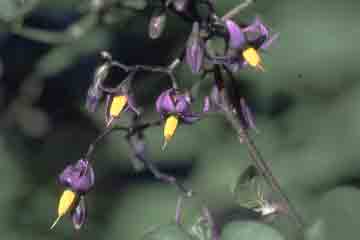 |
Climbing nightshade, Solanum
dulcamara
L. (left, right). The climbing nightshade is another,
rather decorative Old World plant usually usually found growing on disturbed
ground. While it is considered a weed, it is not a particularly agressive
one. The flowers’ reflexed deep purple petals and joined beak-like yellow
anthers identify the plant. The leaves and unripe fruit are poisonous, but
its ripe, bright-red berries are said tio be toxic only in large quantities.
If you taste a berry you will find that it is sweet for a microsecond but
then becomes intensely bitter. The name dulcamara means
"bittersweet." |
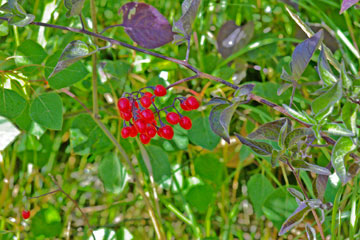 |
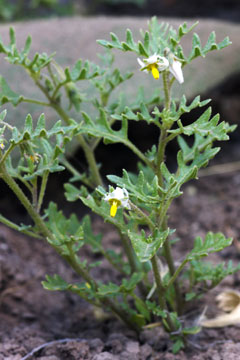 |
Cut-leaf nightshade (wild tomato), Solanum
triflorum Nutt. (left) is,
unlike the plant above, a native that grows to mid-elevations in our mountains.
It is characterized by white flowers with protruding yellow columns of fused
anthers, and by pinnate, pubescent (hairy) leaves. The fruit is a green or
yellow berry that resembles a small tomato--this plant vaguely resembles
a tomato plant. While not as well known as the climbing nightshade,
it is believed to have similar hallucinogenic properties.
Its fruit is variously reported to be edible, or mildly toxic. (We would
advise against experimenting with any of the plants shown on this
page!)
Black henbane, Hyoscyamus
niger L. (right).
Given its striking appearance, black henbane is recognizeable at first glance.
An Old World plant, it is considered a noxious weed in Idaho and in several
other states, for it is toxic to livestock. Henbanes contain generous amount
of the alkaloid hyoscine (scopolamine) used for millennia as a sedative,
and for its atropine-like properties. Scopolamine has been used in obstetrics
to induce “twilight sleep,” as an adjunct to anesthesia,
and—reputedly—for extracting confessions. |
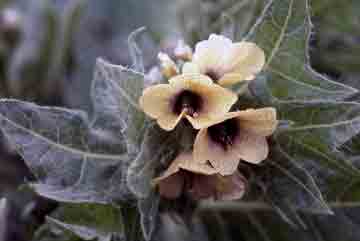 |
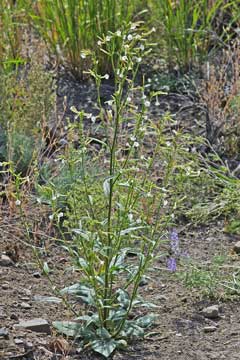 |
Coyote tobacco, Nicotiana
attenuata Torr. ex S. Wats.
(left, right) is the only tobacco plant found in Idaho.
It is one of several smoked by Native Americans (others include Nicotiana
quadrivalvis and N. rustica). Our plants tend to be tall, have
a basal rosette of wide leaves, long-tubed .flowers typical of the genus,
and a pronounced tobacco smell. They are said to grow as high as treeline.
Nicotiana cultivars are used as ornamental plants.
"Indian tobacco," Lobelia inflata L. in the bell-flower
family (Campanulaceae), is an unrelated plant. It contains lobeline,
an alkaloid somewhat similar to nicotine. The plant is not
found in Idaho. |
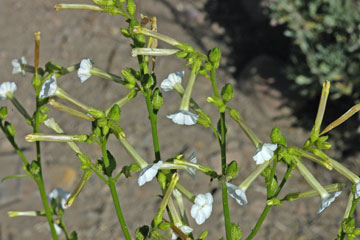 |
Home | Next |
Previous | Index |
Purchase book





